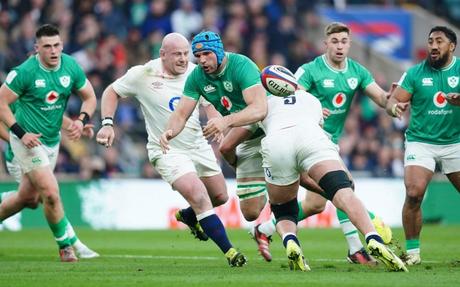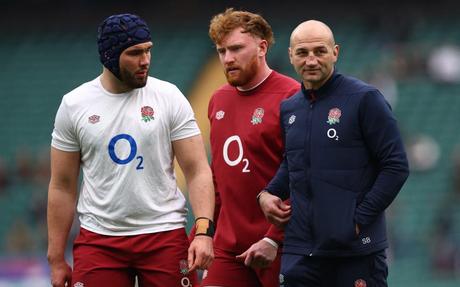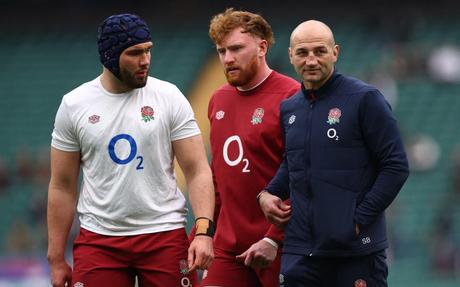
A minute before half-time at Twickenham, Ireland were playing with a penalty advantage in England's 22 when Tadhg Beirne began running onto Jack Crowley's flat pass towards an apparent hole in the England defensive line.
As soon as Beirne receives the ball, he is enveloped by George Martin's gigantic frame, forcing the Irish lock to knock and his soul momentarily leaving his body. With Beirne on the ground, Martin stands over his fallen prey. There was no nonsense, but a message was sent with a long, silent stare. Ireland went into halftime with a 12-8 lead, but England had the upper hand physically, if not psychologically.
Of course, this is not the first time that Martin has left his mark on a fellow second row. In the World Cup semi-final, Martin's monstrous goal on Franco Mostert, which also forced a knock on him, entered the pantheon of great English rugby tackles alongside Josh Lewsey on Mat Rogers, Courtney Lawes on Telusa Veainu and Jonny Wilkinson on Justin Bishop.
Watching from a distance was new Leicester Tigers head coach Dan McKellar, who saw his new leadership take his reputation into a new stratosphere. "There aren't many players who can take it to the South African forwards like this," McKellar said Telegraph Sports. 'You could see him shaking them. George has what you can't really coach and that's that annoying edge. He likes the clashes. He likes that physicality.
"Even when I first started talking to the club last year, I watched a game against Saracens when they were starting to turn the season around and George was hitting people left, right and centre. His low tackle is just so aggressive and dominant. He produced that against the South Africans. I had already taken note of him, but I think the whole world paid attention to him that particular evening."
It is notable that Martin was not fit for the start of last year's World Cup or this year's Six Nations, but on both occasions Steve Borthwick, the England head coach, reintegrated him at the first opportunity available. That's the kind of treatment usually reserved for a senior, seasoned international, rather than a 22-year-old with 10 caps.
The story continues


He was still a teenager when he was called up by Eddie Jones when he had just six league appearances to his name for Leicester. Privately, the former England head coach said Martin had the best technique of any striker he has ever coached, leading him to make his debut against Ireland in the 2021 Six Nations.
At 6 feet tall and weighing 14 pounds, Martin's physical gifts are evident. Yet there are all kinds of physical lumps in rugby that cannot be hit like Martin. In fact, two of his first coaches, Emyr Lewis of Loughborough Grammar School and Jamie Taylor of Leicester Academy, believe that Martin flourished despite his physique and not because of it.
"Obviously he has tremendous physical advantages, but he never allowed his physical advantages as a teenager to become a handicap for him later on," Taylor said. "When you are so dominant as a young player, it is very, very difficult to do that. If you're not careful, everyone will make you a superstar and you'll assume you don't have to work hard.
"Until he was a senior player, rugby wasn't a huge challenge physically. Unlike a lot of players, especially with the way the English talent trajectory has gone, there are a lot of kids who became stars overnight but then quickly fell away because when you play against men the game becomes very different. George has done a great job of getting around that."
As a teenager, if you are physically more developed than your peers, you can rely more on your height than on his skills; an advantage that disappears when they start playing adult rugby. If you can kiss, you'll never have to fight again.
"He didn't just say 'give me the ball, I'll run through people,'" Lewis said. "He could do that, but he let the ball do the work. His instinct was to pass the ball and that was a big part of his development, rather than just running over people. He really focused on his fundamentals."
Much of the credit for this goes to his father David, an accountant, and mother Claudia, a lawyer, who kept him firmly grounded. What stood out to Martin more than his technique at a young age was his drive. When I ask both Lewis and Taylor what their most important memory of Martin was, they don't choose a tackle or a trophy, but the way he dealt with adversity.
For Lewis, this was on an under-14s tour to Belfast, where they faced the famous Royal Academicals. "They absolutely hammered us and gave us 40 points," Lewis said. 'But the conversation after the game was about George. Even though we lost quite badly, he continued to carry the fight. He hates losing. Absolutely hates it. And even though we were outmatched, he carried the guys with him."
Similarly, Taylor recalls Martin's frustration at not performing more during training sessions as part of an academy intake with Freddie Steward, Jack van Poortvliet and Ollie Chessum. In that golden generation, Martin's special quality was what Leicester called his 'momentum score'.
"That's one of the key differentiators in certain positions," Taylor said. "It's mass times speed. As a young player it was very high. I have no doubt that it is also very high now. He's such a skilled tackler. He consistently puts himself in a low position, which is difficult for a big man, consistently squares off on the sidelines and consistently puts his body in front.
"That's because of the work he has done on his technique. He really cared about what he did. It mattered to him a lot. He was a good tackler, but nowhere near what he is now. Now he is one of the best tacklers in world rugby."
Lewsey on Rogers
This was especially delightful as it was the culmination of a mini-blood feud that had escalated between the England winger and the Australian returnee during a 2002 Test in Melbourne. Barely a minute after the pair attacked handbags, Mat Rogers received what can only be described as a hospital pass, allowing Josh Lewsey to absolutely target him to the ground with a missile from what was literally a bone-crunching tackle.
"It ruined my surfing career," Rogers said. "One of the ribs he broke was a little higher than before and I can no longer lie comfortably on a surfboard because my rib is sticking out."
Skinner on Cécillon
Known simply as 'The Tackle' from the 1991 World Cup quarter-final against France. With the score at 10-10, France have an attacking scrum deep in the England 22. Marc Cécillon picks up and drives towards the line, but flanker Michael Skinner reads his movement perfectly, not only stopping the French number 8 in his tracks, but it also drives him back five meters. England then wins 19-10.
Wilkinson on Bishop
You could easily make a list of Jonny Wilkinson tackles yourself, as he redefined the parameters of what a fly-half could do in defence. Many people would have his hit on Emile Ntamack as a better pure tackle. But what precedes it makes Justin Bishop's tackle in the 2003 Six Nations match against Ireland all the more impressive in what was arguably the pinnacle of Clive Woodward's Five-Six Nations era. In the same phase of play, Wilkinson stops Geordan Murphy twice before picking Bishop up and driving him into the Lansdowne Road ground.
Lawes on Veainu
Like Wilkinson, Courtney Lawes has an extensive catalogue, mainly of French halfbacks, but he chose this one as his personal favorite and who are we to argue with the great man. Rather than being a bone-cruncher, this was a try-saving coverage tackle. Telusa Veainu, one of the fastest players in the Premier League, had intercepted Henry Slade and was almost celebrating when Lawes, who had sprinted at least 50 yards, appeared out of nowhere to knock the ball out of his hands as he headed for the line dived. .
Maarten on Mostert
It may not have the visual impact of the other tackles, but what it lacked in aesthetics was made up for by the message it sent that England could take on the bully Springboks in last year's World Cup semi-final. South Africa used their heavy ball carriers to push their way inexorably towards the England try-line. Franco Mostert drove forward as Martin, a surprise selection by head coach Steve Borthwick, met fire with fire with a strike that dislodged the ball. Afterwards, Martin looked back: "That was good. I enjoyed that."
